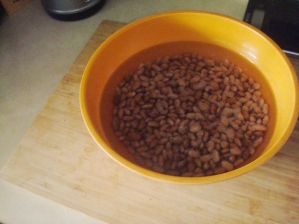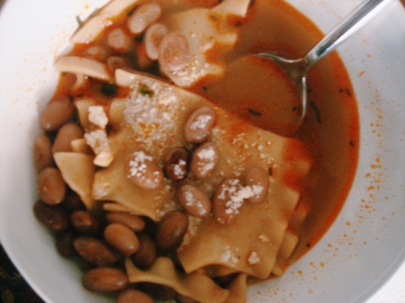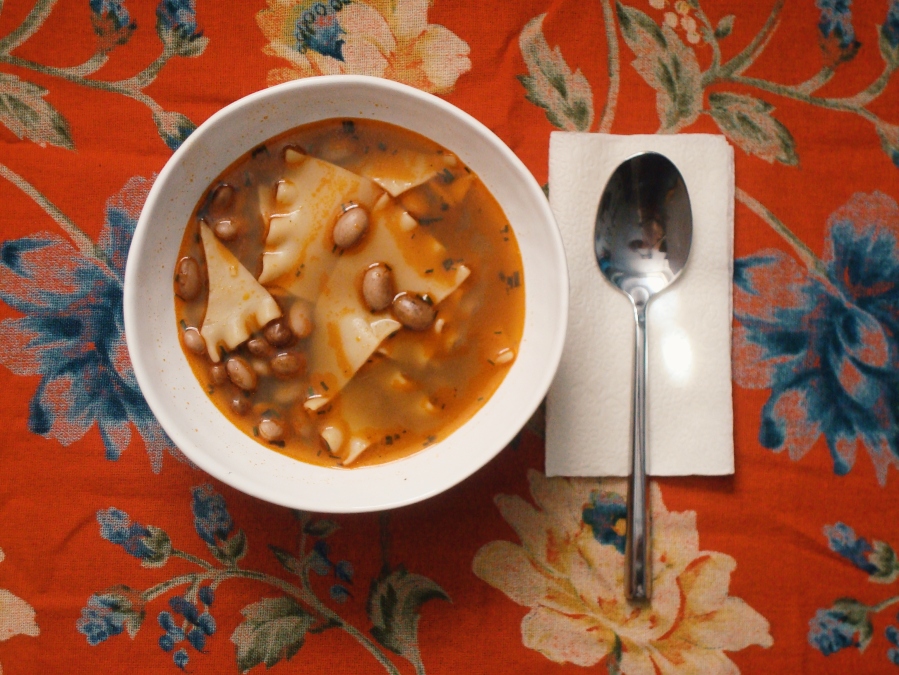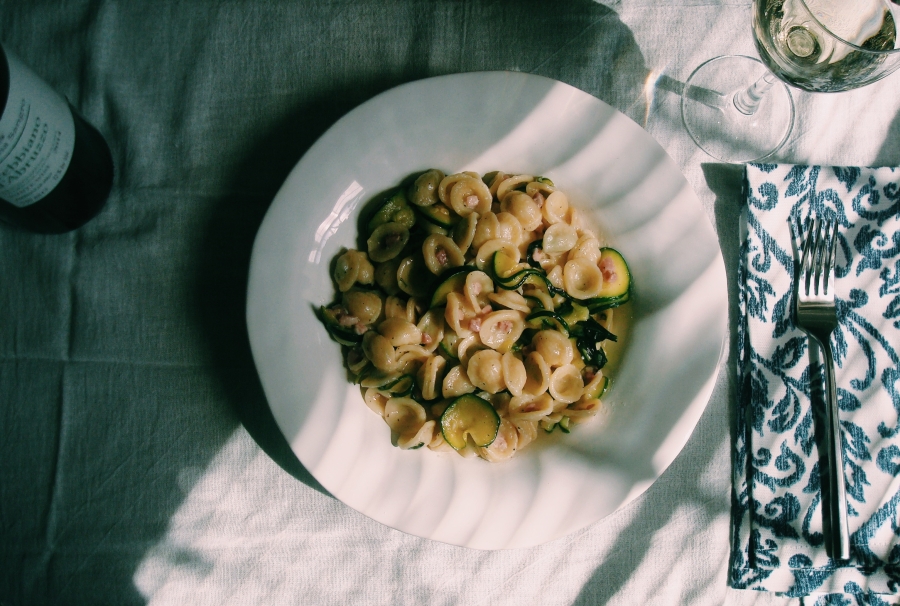I had grand plans for this weekend. Even though I’m no longer in school, there’s something about this time of year that begs for turning over a new leaf and starting fresh with new organizational systems and plans to keep them. I was going to give my small kitchen a good deep clean and try to reorganize the pantry cabinet. I wanted to be merciless in cleaning out my closet and reorganizing clothes. As far as this blog goes, I had planned to get up early and go to the farmers market for ripe local red peppers and tomatoes. I wanted to get one of those charcoal grilling tins to roast the peppers outside for the bright and summery roasted red pepper sauce I planned to write about here today.
But I got sick. My throat is burning, my head aches, and my ears are clogged. Nothing above was accomplished, but I did still cook. I didn’t make the aggressively fresh and seasonal dish I planned to share originally, but instead I made my favorite soup – Pasta e Fagioli.

I’ve called this recipe “Pasta e Fagioli alla Calabrese” because it is my best attempt at recreating the version of pasta e fagioli to which I was treated while visiting my dad’s cousin a few years ago in Castellabate, a town about two hours south of Naples in the Calabria region of Italy. Unlike my grandfather’s version which, while equally delicious, is made with whole-peeled tomatoes and becomes more of a stew by the end, I don’t *think* my dad’s cousin used tomatoes, and her’s stayed soup-like – the pasta and beans sitting in an amazing garlicky broth with a bit of heat from some paprika. I opted for this version of pasta e fagioli over my grandfather’s this weekend for the garlicky broth to soothe my very sore throat. My dad’s cousin used roughly cut, likely handmade, pasta, but I’ve cheated and used roughly broken lasagna sheets (see above, I am sick. I didn’t want to expend that kind of effort to make pasta from scratch today).
Most of you might want to bookmark this one for cooler days ahead, but to anyone else suffering with a late summer cold, this one’s for you. You could easily half this recipe, but I like making large quantities to have for lunch throughout the week. It also freezes well.
Pasta e Fagioli alla Calabrese
Cooking time: ~2.5 hours | Serves 8
- ~.75 lbs (380 g) dried pinto or cranberry (borlotti) beans
- 6 cloves garlic, 3 whole, 3 crushed
- 1 large celery stem, cut in pieces
- 2 bay leaves
- 4 tablespoons olive oil
- About 10 (.5 lbs) lasagna sheets, roughly broken
- 1 tbsp smoked paprika + more to taste
- Handful of fresh chives, chopped
- salt, pepper
- Soak the dried beans in a large bowl of water for at least 6 hours, or overnight. Before you begin cooking, drain the beans and rinse well.
- Put the beans in a large pot and fill with water so that the water level is at least 3 inches above the beans. Bring the water to a simmer.
- After a half hour of simmering, skim off the foam at the top of the water, then put in the 3 whole garlic cloves, the the celery pieces, bay leaves, 1 tablespoon of olive oil, ~tbsp of salt, and ~tsp of black pepper. Continue to simmer for ~30 minutes then add the broken lasagna sheets. Continue to simmer for another 15 minutes then check to see if the pasta is soft, and taste the beans. If the beans are still a bit hard and chalky, continue to simmer and check at 10 minute intervals until done.
- Meanwhile, in a large, heavy-bottomed pot, heat the remaining 3 tablespoons of olive oil over medium heat. Add the crushed garlic and fry until golden. Remove the garlic (I add the fried garlic to the simmering beans for more garlicky flavor, or you could just discard it) and take the pot off the heat. Stir in the paprika.
- When beans and pasta are soft, carefully transfer the contents of the bean pot to the olive oil and paprika, removing the bay leaves, garlic, and celery as you go. Stir in fresh chives, if using. Let sit, covered, for at least 30 minutes.
- Serve in bowls with parmesan cheese and additional paprika to taste.





